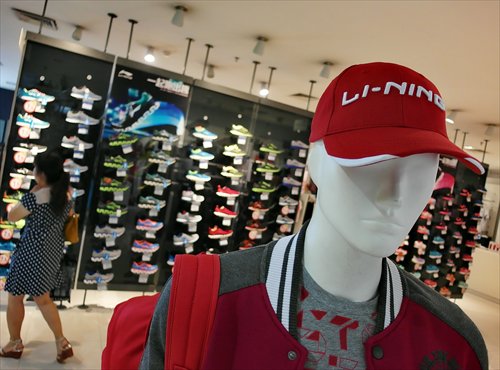HOME >> BUSINESS
Li Ning stumbles in finding its way
Source:Reuters-Global Times Published: 2014-9-3 21:23:01
Chinese sports giant facing big challenges as it loses ground to both Western, local rivals

A mannequin inside a Li Ning store in Yichang, Central China's Hubei Province Photo: CFP
In 2010, former Chinese gymnast Li Ning led a surging $4 billion sportswear business, a gold-medal pinnacle echoing his victories at the 1984 Olympic Games.
Now, the Li Ning business is more reminiscent of the ex-sportsman's exit from the 1988 Olympics without a podium finish.
As customers have turned to aspirational global brands like Nike and adidas or cheaper local firms, Li Ning has racked up heavy losses, losing four-fifths of its market value.
The company has long pinned a turnaround plan on targeting trendy, fast-growing areas of sport in China, like basketball, hoping to attract younger consumers with a mid-range pricing strategy. But company watchers fear what Li Ning sees as the middle ground could turn out to be a no-man's land, while still-loyal older customers may be turned off by the focus on youth goods.
"They tried to go younger, but in the course of doing so they lost a lot of those aged over 30 who were traditionally a more loyal customer base," said James Roy, senior analyst at China Market Research Group in Shanghai.
Equally, many younger customers have yet to buy into the strategy.
"It seems like [Li Ning] products are targeted mostly at students aged 13 or 14," Ding Jianan, a 22-year-old student, told Reuters in Shanghai.
"I can afford higher-priced items from Western brands, which offer better quality. In college, people like to compare each other's outfits so the peer pressure will push us to buy Nike or adidas."
Uncertain recovery
Li Ning, backed by private equity powerhouse TPG Capital and Singapore wealth fund GIC, last month reported a first-half net loss of nearly $100 million, more than three times that of the same period a year earlier.
It said at the time its recovery could take up to two more years as it invests hundreds of millions of dollars in promotion and advertising. The company declined to comment for this article.
"It's hard to say if their direction (of transformation) is right or not when the loss is getting bigger and bigger," said Steve Chow, analyst at Sunwah Kingsway Group Research.
In contrast, ANTA Sports Products Ltd, China's biggest footwear retailer by market value, registered a 28 percent rise in first-half net profit, beating market forecasts, according to the financial results released by the company in August.
ANTA, which has retail stores and counters in Southeast Asia, Eastern Europe and the Middle East, said it had expanded its presence in emerging markets in the first half and singled out growth in children's products and its e-commerce business for its solid performance.
ANTA's chairman Ding Shizhong said at a results conference in August that the company was the first among its peers to recover, although that did not mean others would bounce back at the same pace as the industry still faced uncertainty due to a lack of product differentiation and fierce competition.
Advertising blitz
Li Ning's efforts to recapture its glory days by appealing to a younger generation have been evident in its product design and high-profile marketing campaigns using Western sports stars.
Bright colors, including hot-pink basketball shoes that retail for $289 a pair and loud green polka-dot trainers, have increasingly replaced the classic red and white look favored by founder Li Ning himself that resonated with the company's traditional market in its heyday.
Li, who is now executive chairman, declined to comment.
In that price range, Li Ning is positioning itself above local competitors such as ANTA and Peak Sport, but slightly below foreign rivals Nike and adidas.
It's a strategy that has yet to bear fruit. The company's declining fortunes provide a stark contrast to the positive results from homegrown rivals as China's sportswear industry shows solid signs of recovery following an expansion blitz after the 2008 Beijing Olympic Games that led to bloated inventories.
Li Ning's push to revive the brand has seen a multimillion dollar marketing drive that included signing up NBA basketball superstar Dwayne Wade.
The company's promotion and advertising expenses accounted for 19.4 percent of its 3.14 billion yuan ($511 million) revenue in the first half of 2014, compared with 10.8 percent at ANTA.
Even as Li Ning invests to try to build the brand, the company still faces inventory issues that can affect its reputation, said James Button, a director at Shanghai-based consultancy SmithStreet.
"They're trying to say they're a high-quality brand and are at the same level as foreign players, but at the same time it is very visible that they're dumping inventory at very low prices," he said.
The company has said it is prepared to take the time it needs to achieve its goal of making Li Ning the only brand that represents the "Chinese Dream" - the ideal of individual success in the country's society - across all categories of sportswear.
"I think Li Ning is so tied in with the Chinese Dream ... it's more a part of national positioning than it is sports positioning," Button said.
Reuters - Global Times
Posted in: Insight